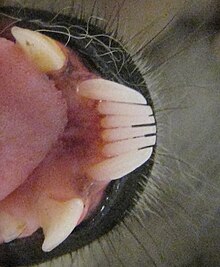Toothcomb


- This article is about the tooth structure, for the comb see nit comb.
A toothcomb (tooth comb, dental comb) is an anatomical structure found in certain Strepsirhine primates, in particular those of the infraorder Lemuriformes, which includes the lemurs of Madagascar. A toothcomb consists of long, flat forward-angled teeth,[1] and includes the lower incisors and the canine teeth.[2] In indriids, archaeolemurids, palaeopropithecids, the structure consists of four teeth, but it consists of six teeth in all other lemurs except for the highly derived Daubentonia (Aye-aye), which has replaced the toothcomb with a single pair of continuously growing anterior teeth.[3] The first lower premolar following the toothcomb is usually shaped like a typical canine tooth.[2] Lemur toothcombs contain microscopic grooves that allow the toothcomb to be used for personal grooming and occasionally foraging.[1]
The first fossil Strepsirhine found to exhibit a toothcomb was Karanisia clarki, an extinct species of loris dating to the Middle Eocene (c. 40 million years ago) and found in Egypt.[3][4] This find, along with the lack of lemur fossils in Madagascar and Africa, has complicated the puzzle of lemur origins and diversification.[3]
References
- ^ a b "New fossils add to primate-origins debate - Fine Toothcomb". Science News. 2003. Retrieved 2008-08-10.
- ^ a b Macdonald, David (2006). "Primates". The Encyclopedia of Mammals. The Brown Reference Group plc. p. 292. ISBN 0-681-45659-0.
- ^ a b c Gould, Lisa and Sauther, Michelle L., ed. (2006). Lemurs: Ecology and Adaptation (Developments in Primatology: Progress and Prospects) (1 ed.). Springer. p. 7–8. ISBN 038734585X.
{{cite book}}: CS1 maint: multiple names: editors list (link) - ^ Seiffert, E. R. (2003). "Fossil evidence for an ancient divergence of lorises and galagos". Nature. 422 (6930): 421–424. doi:10.1038/nature01489. PMID 12660781.
{{cite journal}}: Unknown parameter|coauthors=ignored (|author=suggested) (help)
